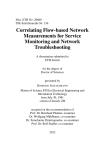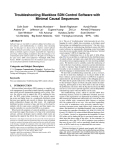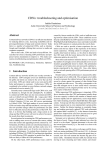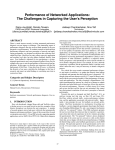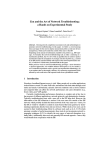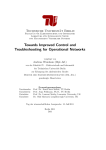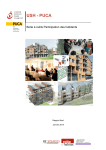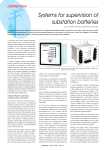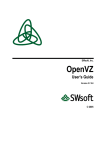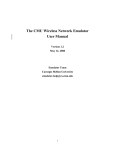Download Network Troubleshooting with Mirror VNets
Transcript
Network Troubleshooting with Mirror VNets
Andreas Wundsam, Amir Mehmood, Anja Feldmann
Olaf Maennel
TU Berlin / Deutsche Telekom Laboratories, Germany
{andi, amir, anja}@net.t-labs.tu-berlin.de
Loughborough University, UK
[email protected]
Abstract—Today diagnosing problems, deploying new services,
testing protocol interactions, or validating network configurations
are still largely unsolved problems for both enterprise and
Internet Service Provider (ISP) networks. Due to the intrinsically
distributed nature of network state, frequent timing dependencies, and sources of non-determinism involved, any change
may introduce undesired effects—even the impact of a simple
configuration change can be hard to predict.
In this paper we show how to leverage network virtualization
to improve our debugging ability: By replicating and cloning
production networks and then applying the changes to the
cloned network in a safe fashion. Mirror VNets thus enable
troubleshooting as well as safe upgrades to both software and
configuration.
I. I NTRODUCTION
Despite all efforts, problem diagnosis, troubleshooting and
safe evolution of networks remains a challenging problem
due to their distributed nature. As such, diagnosis is often
attempted in “artificial” environments (analytical models, simulators, testbeds) that offer good monitoring capabilities, or in
a trial-and-error fashion in the actual production environment.
However, these approaches have severe limitations: Models
and simulations have limited prediction capabilities due to abstract modeling assumptions, testbeds are limited in scale due
to their costliness, and trying to fix things on the production
network often leads to other errors [16], [24]. Therefore, all
these approaches often do not suffice to diagnose and then
resolve real-life network problems since these often stem from
complex interactions of many parties. Problems that only occur
sporadically or are triggered by user interactions are known to
be especially problematic, even if it is possible to replicate a
complete setup in a lab environment.
We propose to utilize Virtual Networks (VNets) to help
tackle these network diagnosis and troubleshooting problems.
VNets expand the existing concepts of virtualized hosts and
links to the entire network. Therefore, a VNet may span
multiple physical network domains. Note that virtualized and
shared resources are already common in today’s networks.
Examples include Ethernet VLAN’s and MPLS, VPN’s and
VRF tables, IP service over DSL lines, shared undersea
cables, shared mobile phone stations, etc. VNet management
frameworks unify the management of these resources and
enable VNets to be dynamically provisioned and configured
and to operate in parallel on a shared physical infrastructure.
A controlling instance isolates the individual VNets from each
other. As a result, it is possible to experiment with one VNet,
while maintaining stability in the rest of the system.
In this paper we show how properly implemented VNets
enable us with good diagnosis and debugging capabilities. We
propose Mirror VNets, which replicate networks and traffic in
a safe fashion. Thus, the new Mirror VNet and the production
VNet can operate in parallel and the user traffic is duplicated
either completely or in part to both networks.
This allows the network owner to investigate a problem and
locate its root cause in the Mirror VNet without interfering
with the production traffic. Then, a fix can be developed,
tested, and deployed even with real user traffic again without
affecting the production setup. Once the network operator is
convinced that the new setup is stable and fixes the problem
he can switch the production VNet with the Mirror VNet in
a near-atomic fashion. Therefore, Mirror VNets offer network
operators a new range of capabilities from (a) safely evaluating
and testing new configurations, via (b) testing new software
components at same scale of the production network and under
real user traffic, to (c) troubleshooting live networks.
This approach builds on the agility and isolation properties of the underlying virtualized infrastructure and does not
require changes to the physical or logical structure of the
production network. Instead, a network owner can dynamically
provision a Mirror VNet as required. It does not require
changes to the production network within the VNet— its
protocols, its applications, or its configuration.
This paper makes the following contributions: (i) we introduce Mirror VNets, (ii) discuss their intrinsic benefits and
limitations (iii) present an implementation based on XEN
and OpenFlow and (iv) demonstrate its usefulness in a case
study. We conclude that Mirror VNets have the potential to
substantially ease network operation and improve resilience
against mistakes.
Our work bears some similarities to the Shadow Config
approach by Alimi et al. [6], designed to improve the safety
and smoothness of configuration updates, but by virtue of
the underlying virtualization extends the scope beyond configuration changes. Another sibling to our approach has been
proposed by Lin et al. [23]. The authors introduce a framework
that enables full reproducibility by recording and replaying all
non-deterministic events. Note that the necessary coordination
and transaction modules inside the Hypervisor add significant
complexity to the production datapath and thus cannot be
fully transparent to the production network. Numerous other
approaches for improving troubleshooting support in networks
have been proposed. Some authors [8], [18] propose adding
pervasive tracing support throughout the network, which is
/dev/null
Fig. 1.
Substrate running production VNet A, consisting of VNodes
1a, 2a, 3a, and Mirror VNet B, consisting of VNodes 1b, 2b, 3b
difficult because it requires changes to all involved hosts,
routers, and software stacks. Automatic inference [5], [10],
[27] can help debug many problems. The scale of testbeds can
be increased with the help of time-dilating frameworks [19],
[20], but sporadic problems remain challenging to reproduce.
A complementary approach [21] is to use virtualization to
improve bug-tolerance in software routers.
II. M IRROR VN ETS
In this section, we show how network virtualization enables
Mirror VNets. Then we discuss Mirror VNet use-cases and
discuss their intrinsic benefits and limitations.
A. Assumptions
Our approach is based on the assumption that the network
is virtualized. This includes node as well as link virtualization with proper isolation and resource management and
accountability. As mentioned, many virtualized resources are
present even in today’s network infrastructures, e.g., VLANs,
MPLS, VPNs, and comprehensive management frameworks
are currently emerging. Virtualization is also considered a key
enabler the Future Internet [17]. In addition, we assume that
the infrastructure is shared among a reasonable number of
VNets and thus none of the VNets uses more than a fraction,
say 10%, of the overall substrate resources.
Another assumption is that we can duplicate input traffic to
multiple VNets. Such capability is also commonly deployed
in today’s network infrastructure, e.g., spanning ports on
Ethernet switches, multicast in routers, optical splitters, lawful
intercept, and the functionality offered by OpenFlow.
B. Approach
To upgrade or troubleshoot, e.g., a production VNet
(VNet A) in Fig. 1, the operator clones it and pairs it with
a parallel Mirror VNet (VNet B). Thus VNet B starts with the
identical configuration and state as VNet A, e.g., by relying on
the same techniques as used for network node migration. The
operator ensures that the input traffic for VNet A is mirrored
either completely or in part to VNet B. This has to happen at
all attachment points between the VNet and external entities,
e.g., end-systems or network entry points. Therefore, any user
traffic traverses both VNets. However, only traffic from the
production VNet A is send back to external nodes. Traffic
from the Mirror VNet B is discarded, silently.
Both VNets A and B now operate in parallel. Moreover, they
are fully isolated from each other, on a node- and link-level.
Thus, from now on they operate independently but under the
same (or partial) user traffic. This means that it is now possible
to use VNet B to troubleshoot network problems, test a new
software or hardware release or reconfigure the network.
Once the problem has been diagnosed and a solution has
been found, deployed to the Mirror VNet B and validated,
the Mirror VNet B can be upgraded to become the new
production VNet. To this end, the VNet attachment points of
both VNets to external hosts are swapped: External hosts now
communicate with VNet B, and VNet A acts as a Mirror VNet,
and its output is discarded. This is a relatively simple operation
and can be completed quickly. Finally, the old VNet A can be
dismantled and its substrate resources released.
Note that not all traffic has to be mirrored and not all
mirrored traffic needs to be transmitted over the wire. Depending on the scenario, the operator can use mirror strategies to
adapt the volume of the traffic to be mirrored and transmitted.
Possible Mirror strategies include: (a) Full Mirror: Every
packet is mirrored verbatim and transmitted independently in
both VNets. (b) Packet Headers: Only packet headers are
transmitted in the Mirror VNet, the payload is reconstructed
with dummy data at the nodes. (c) Traffic Stats: Instead of
actual packets, only aggregated traffic statistics are transmitted
and similar traffic is reconstructed at the nodes under investigation. (d) Sampling: Only a selected fraction of packets or
flows is mirrored to the Mirror VNet.
These strategies can dynamically and selectively be applied
to parts of the traffic. Note, for instance, that Control plane
traffic has been shown to account for < 1% of traffic volume,
but cause > 95% of bugs [7]. Accordingly, many problems
(e.g., routing problems) can be investigated by only mirroring
control-plane messages verbatim. For the data-plane traffic,
headers or even reconstructed summaries may well suffice.
Stress testing of a new software release can be started at only
a fraction, e.g., 5%, of the overall traffic.
C. Use-cases
Mirror VNet can be useful in many scenarios, including
routing optimizations and updates of network services.
Routing Configuration Optimization: When a network operator decides that he wants to re-optimize routing, e.g., by
changing the link weights of his interior routing protocol or
by introducing routing policies, he often does not want to
experiment on the production network. Among the drawbacks
are unintentional path choices, link overloads, packet reordering and losses during convergence, erroneous configurations,
etc. However, by using a Mirror VNet he can perform all
changes while traffic in the production VNet continues to flow
unaffected. Indeed, the operator can monitor the Mirror VNET
for the expected benefits or unexpected side effects. Only when
the operator is “happy” with the new configuration state, he
switches roles, and exposes the new routing to his users. The
capacity overhead is very small as it is sufficient to mirror
routing protocol messages exchanged between external entities
and the Mirror VNet.
Update of a faulty network service: Consider a wide area
network service based on an overlay network, e.g., a popular
Internet Telephony system. Suppose a number of overlay supernodes crash in irregular intervals. In this case, the operator
can instantiate a Mirror VNet, in the exact same state as his
production VNet. The bugs responsible for the problem are
tracked down by manipulating selective traffic passed to the
Mirror VNet. When a possible fix has been developed, the
new version is deployed to the Mirror VNet, and an increasing
amount of traffic is mirrored to the Mirror VNet.
This can cause some overhead especially with regards to
bandwidth capacity. However, the benefit is that the new
software components are stress-tested under real user traffic
and are effectively probed for possible unknown regressions.
Circumstances that might be very hard to discover in analytical
models or test-labs. Upon satisfactory results the Mirror VNet
can be swapped with the production VNet.
D. Discussion
The benefits of Mirror VNets are many-fold and include:
Resilience against operational mistakes: Mistakes during
the configuration and/or update process are limited to the
Mirror VNet. Thus they do not affect the production network.
Moreover, the entire change set is tested under realistic conditions before affecting production.
Real user traffic: Mirror VNets expose the new system and
its configuration to real user traffic at full scale and thus offer
the opportunities to detect more bugs earlier.
Complex setups: Some problems can only be reproduced
in complex setups, which can not be reproduced with models,
simulations, or in test-labs. The only way to test under realworld conditions is to deploy in a real network – however,
mirror VNets enable us to do this in a safe manner, without
impacting the reliability of the production network.
Rollback/Undo for Networks: If after being set into production, an upgraded Mirror VNet exposes unexpected problematic side effects (e.g., due to a closed loop effect, see below),
the operator can easily revert back to the old production
network, and continue to investigate the problem without
affecting the production users any longer.
An inherent limitation of this approach is that closed-loop
effects caused by hosts outside the VNets cannot be predicted
by monitoring the Mirror VNet. For example, an upgrade that
provides faster delivery of requests to an external server may
result in faster response traffic which may cause an overload on
the network. Such effects only occur once the Mirror VNet is
made productive and thus cannot be predicted by monitoring
the Mirror VNet while it is still in mirror mode. Note that
closed-loops within the VNets are not affected by this problem,
so one possible solution is to integrate all communicating
parties, including the end hosts, into the VNet itself, and have
the VNet operate end-to-end.
Another concern is that the substrate has to carry the
additional load imposed by the Mirror and the Control VNets.
Note that depending on the problem under investigation, the
mirroring strategies discussed in Section II-B can reduce the
amount of traffic that actually has to be mirrored significantly,
and stress-testing can be done gradually (e.g., at 10% of the
traffic load). Finally, assuming many co-existent VNets on
a well dimensioned (e.g., 2/3 loaded) substrate, debugging
a limited number even at Full-Mirror mode is feasible. If
the impact of a proposed change cannot be determined by
other means, then the capacity-overhead may reflect a fair
price. In the event of an unexpected traffic or load spike,
the production VNets are always granted priority over Mirror
VNets. Therefore, debugging or testing is affected but the user
service in the production VNet is not deteriorated.
III. I MPLEMENTATION O PTIONS
This work assumes the presence of a virtualization solution
that enables duplication of a virtual machine. In addition,
we require the network substrate to be able to dynamically
replicate traffic as required.
Node virtualization: Today, virtualization concepts are already ubiquitous in data centers [9] and router vendors,
including Cisco and Juniper, offer support for virtualized
routers. XEN [11], an open source virtual node monitor or
hypervisor, is among the most commonly used open source
virtualization solutions and allows to run multiple operating
systems side-by-side. XEN has been shown to be a viable
solution for building high performance routers on commodity
hardware [14] if functional blocks are selected and placed
carefully. Performance isolation and fairness issues can be
challenging especially with regards to network I/O [12], [13].
Many other node virtualization solutions are available offering
individual trade-offs between performance and flexibility, e.g.,
VMWare [4], KVM [22], OpenVZ [2]. XEN, and many
others, feature live migration support, which can be easily
extended to enable instant creation of mirror nodes, which
essentially corresponds to a live-migration to localhost,
without disbanding the original guest.
Packet replication: Our approach requires packets to be
duplicated and delivered to two different virtual networks
in parallel. It is known that naively bridging interfaces can
impose severe performance penalties [12]. Fortunately, several hardware accelerated link virtualization technologies are
about to become commercially available, including MultiQueue NIC cards, and OpenFlow. Multi-Queue NIC cards
(e.g., [3]) lower the I/O overhead by allowing packets to
be delivered directly to the target VNode. OpenFlow [25]
enables an external entity, the controller, to control Ethernet
switches. This controller can dynamically set the forwarding
rules using wildcard patterns across the packet headers while
the frame forwarding is done by the switch hardware. Thus,
OpenFlow is a flexible and powerful solution for the link
substrate capabilities required by our approach.
IV. C ASE
STUDY
We present a case study highlighting the potential of Mirror
VNets for troubleshooting a problem in a production network.
We build a prototype system utilizing XEN 3.4 for host
virtualization and OpenFlow 0.8.9 for link virtualization. A
custom OF controller based on NOX serves the purpose of
Node 1
BG Traffic
Sender
Node 2
Node 3
Vnode 2A
Vnode 3A
Vnode 2B
Vnode 3B
BG Traffic
Receiver
TABLE I
E XPERIMENT OUTLINE ACROSS PHASES
VNET A
Vnode 1A
Phase
Active VNets
Production VNet
QoS enabled
BG traffic load
prod
VNET B
Vnode 1B
shadow
VOIP
sender
Vnet entry node
Vnet transfer node
Moni
1
A
A
L
2
A
A
L/H
3
A&B
A
H
4
A&B
A
B
H
5
A&B
B
B
H
6
B
B
B
H
VOIP
receiver
/dev/null
Vnet exit node
Traffic flow
Fig. 2.
Mirror VNet experiment setup
mirroring the incoming traffic to both VNets and filtering
outgoing traffic according to the status.
Consider the following scenario: A VNet operator that offers
both VoIP and Internet access across a best effort VNet,
considers moving to a setup with service differentiation to
offer better quality of service (QoS) to its VoIP traffic.
For our experiment, a VoIP call and background traffic of
varying intensity is routed through the virtualized substrate
(Fig. 2). The substrate network consists of three nodes. We
now instantiate two parallel VNets, VNet A and B, each with
a maximum bandwidth of 20 Mbs throughout the experiment,
enforced by traffic shaping on node 2. Moreover, we setup
an additional virtual network for monitoring. On entry to
the VNet, traffic is duplicated to both VNets A and B and
forwarded within each via node 2 to node 3 using separate
virtual links (VLANs). On exit, when leaving node 3, only
output from one VNet is sent to the receivers. In addition, the
monitoring VNet “Moni” receives a copy of only the VoIP
traffic from both VNets.
Metrics: For our evaluation, we measure at two points in the
experiment: Moni records data for both VNets on exit of the
VNet, while the receiver records the quality as experienced by
the user. We record the percentage of dropped packages on the
VoIP call as a rough quality indicator, and calculate the Mean
Opinion Score (M oS) as defined by the ITU-T E-model [15]1 .
Setup: For the VoIP traffic we use the pjsip [26] client, an
open source VoIP client based on SIP. It generates traffic
at a constant rate of 80 kb/s using the G.711 codec with a
net bitrate of 64 kb/s. Each VoIP RTP packet contains 20ms
voice and has a payload of 160 Bytes. A pool of servers is
used to generate the background traffic, using Harpoon [28],
with properties that are consistent with those observed in the
Internet – heavy-tailed file distributions and self-similar traffic,
emulating the Internet access traffic by the users of the VNet.
To account for different intensities of the background traffic
during different times of the day we use two different load
levels: L/H that correspond to 20-25%, 60-86% average link
utilization. All traffic sources are located on the left in Fig. 2.
1 The E-model states that the various impairments contributing to the overall
perception of voice quality (e.g., drops, delay, jitter) are additive when
converted to the appropriate psycho-acoustic scale (R factor). The R-factor is
then translated via a non-linear mapping to the Mean opinion Score(M oS),
a quality metric for voice. M oS values range from 1.0 (not recommended)
to 5.0 (very satisfied).
Fig. 4. Averaged MoS values per experiment phase, as measured within
VNets A, B and at the end host (receiver).
The experiment is conducted in six phases with a length of
five minutes each. Fig. 3 shows the rate of the background
traffic (shaded area) averaged over 10s (scale on right axis)
across time. In addition, Fig. 3 shows the number of dropped
packets across time, again using 10s bins (scale on left axis).
Drop rates for VNet A are depicted as blue plus signs, VNet B
as red crosses, and the values measured at the receiver as green
diamonds. Table I summarizes the configuration of each phase.
Results: In phase 1, background traffic is running at low
intensity. In the middle of phase 2 the intensity of the Internet
traffic is switched to high. This causes a problem in VoIP
quality as measured by the MoS value, see Figure 4. The
perceived quality drops from a MoS score of 4.34 which
corresponds to a “very satisfied” service level drops to 4.16
which corresponds to a level of “satisfied”.
As such, the VNet operator asks to instantiate a Mirror VNet
at the beginning of phase 3. This means that all packets are
now duplicated at node 1 and are routed in both VNets A
and B. However, the end user for VoIP service is still getting
service through VNet A. This allows the operator to assess
the impact of the degradation and to do root cause analysis in
VNet B. Indeed, the quality of the call decreases further in our
experiment. In our case the operator decides to prioritize VoIP
traffic to counter the bad performance. He enables QoS at the
start of phase 4. Even though the background traffic increases
further in this phase, the QoS reduces the loss rates within
VNet B significantly and the MoS value increases again to
4.38. At the same time, VNet A is hit hard by the increased
traffic, causing heavy congestion. In consequence, the VoIP
MoS score drops to 1.45 (“not recommended”).
At the start of phase 5 the operator switches his production
VNet from VNet A to VNet B. Note that packet drops as
experienced by the end user do not increase noticeably during
the switch. After the switch is completed, the user can profit
25
20
15
10
5
0
0
BG traffic throughput [MBit/s]
phase 6
phase 5
phase 4
phase 3
phase 2
phase 1
40
20
10
packet drops %
30
Receiver
VNET A
VNET B
BG Traffic
0
500
1000
1500
Experiment time [s]
Fig. 3.
VoIP packet drops (left) and background traffic throughput (right) across time
from the good performance provided by VNet B. With phase 6
the operator deactivates VNet A.
This very simple scenario shows how an operator can benefit
from Mirror VNets, e.g., to smoothly upgrade his network
configuration to amend a network performance problem. Early
results indicate that the approach also works for the other use
cases mentioned in Section II-C and that it can scale to larger
topology sizes. Ongoing evaluation within larger OpenFlowenabled infrastructures that are currently being deployed will
provide additional insights into the scalability.
V. S UMMARY
AND FUTURE WORK
In this paper, we present an approach that adds network
troubleshooting capabilities to virtualized enterprise or ISP
networks. Mirror VNets enable operators to upgrade configurations and software in an operationally safe manner with
transaction semantics while exposing the new system and
configuration to real user behavior. Less expensive, specific
problems can be investigated and debugged, and interactions
can be studied by sending only selected traffic to the Mirror
VNet, e.g., control plane messages. The experiences with
our prototype implementation underline the feasibility of the
approaches, especially if used on a virtualization platform that
offers good isolation. In the future, we plan to further evaluate
the scalability of the system in the large scale OpenFlowenabled testbeds currently planned, e.g., the Ofelia testbed [1].
The debugging capabilities of Mirror VNets are of particular
interest in such environments where real users are using
experimental software.
R EFERENCES
[1] EU Project Ofelia. http://http://www.fp7-ofelia.eu/.
[2] Openvz. http://wiki.openvz.org/.
[3] Solving the hypervisor network I/O bottleneck. http://www.solarflare.
com/technology/documents/SF-101233-TM-5.pdf.
[4] Vmware infrastructure. http://www.vmware.com/products/vi/.
[5] M. K. Aguilera, J. C. Mogul, J. L. Wiener, P. Reynolds, and A. Muthitacharoen. Performance debugging for distributed systems of black
boxes. In ACM SOSP, 2003.
[6] R. Alimi, Y. Wang, and Y. R. Yang. Shadow configuration as a network
management primitive. In Proc. ACM SIGCOMM, 2008.
[7] G. Altekar and I. Stoica. Focus replay debugging effort on the control
plane. Technical Report UCB/EECS-2010-88, UC Berkeley, 2010.
[8] A. Anand and A. Akella. Netreplay: a new network primitive. In ACM
HotMetrics Workshopt, 2009.
[9] M. Armbrust, A. Fox, R. Griffith, A. D. Joseph, R. H. Katz, A. Konwinski, G. Lee, D. A. Patterson, A. Ra bkin, I. Stoica, and M. Zaharia.
Above the clouds: A berkeley view of cloud computing. Technical
Report UCB/EECS-2009-28, 2009.
[10] P. Bahl, R. Chandra, A. Greenberg, S. Kandula, D. A. Maltz, and
M. Zhang. Towards highly reliable enterprise network services via
inference of multi-level dependencies. In Proc. ACM SIGCOMM, 2007.
[11] P. Barham, B. Dragovic, K. Fraser, S. Hand, T. Harris, A. Ho, R. Neugebauer, I. Pratt, and A. Warfield. Xen and the art of virtualization. In
ACM SOSP, 2003.
[12] S. Bhatia, M. Motiwala, W. M¨uhlbauer, Y. Mundad, V. Valancius,
A. Bavier, N. Feamster, L. Peterson, and J. Rexford. Trellis: A platform
for building flexible, fast virtual networks on commodity hardware. In
ACM ROADS Workshop, 2008.
[13] N. Egi, A. Greenhalgh, M. Handley, M. Hoerdt, F. Huici, and L. Mathy.
Fairness issues in software virtual routers. In ACM PRESTO Workshop,
2008.
[14] N. Egi, A. Greenhalgh, M. Handley, M. Hoerdt, L. Mathy, and T. Schooley. Evaluating xen for router virtualization. In IEEE PMECT, 2007.
[15] The E-model, a Computational Model for Use in Transmission Planning,
ITU-T Rec. G.107, 2005.
[16] N. Feamster and H. Balakrishnan. Detecting bgp configuration faults
with static analysis. In USENIX NSDI, 2005.
[17] A. Feldmann. Internet clean-slate design: what and why? ACM Sigcomm
CCR, 37(3), 2007.
[18] R. Fonseca, G. Porter, R. H. Katz, S. Shenker, and I. Stoica. X-trace:
A pervasive network tracing framework. In USENIX NSDI, 2007.
[19] D. Gupta, K. Vishwanath, and A. Vahdat. Diecast: Testing distributed
systems with an accurate scale model. In USENIX NSDI, 2008.
[20] D. Gupta, K. Yocum, M. Mcnett, A. C. Snoeren, A. Vahdat, and G. M.
Voelker. To infinity and beyond: Time warped network emulation. In
ACM SOSP, 2005.
[21] E. Keller, M. Yu, M. Caesar, and J. Rexford. Virtually eliminating router
bugs. In Proc. ACM CONEXT, 2009.
[22] A. Kivity, Y. Kamay, D. Laor, U. Lublin, and A. Liguori. kvm: the linux
virtual machine monitor. In Proc. of the Linux Symposium, 2007.
[23] C.-C. Lin, M. Caesar, and J. van der Merwe. Towards interactive
debugging for isp networks. In ACM HotNets Workshop, 2009.
[24] R. Mahajan, D. Wetherall, and T. Anderson. Understanding bgp
misconfiguration. In Proc. ACM SIGCOMM, 2002.
[25] N. McKeown, T. Anderson, H. Balakrishnan, G. Parulkar, L. Peterson,
J. Rexford, S. Shenker, and J. Turner. Openflow: enabling innovation in
campus networks. ACM Sigcomm CCR, 38(2), 2008.
[26] Open Source SIP Stack and Media Stack for Presence, Instant Messaging, and Multimedia Communication, 2009. http://www.pjsip.org.
[27] P. Reynolds, J. L. Wiener, J. C. Mogul, M. K. Aguilera, and A. Vahdat.
Wap5: black-box performance debugging for wide-area systems. In ACM
WWW, 2006.
[28] J. Sommers and P. Barford. Self-configuring network traffic generation.
In ACM IMC, 2004.





